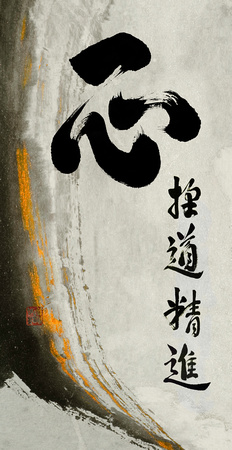ShoDo - notes on wielding the Ink Brush
ShoDO
the Way of the Brush
The beginnings of Chinese – Japanese Brush-writing are thought to date back approximately 4500 years into ancient China. Chinese Characters, called Kanji in Japan, are considered the earliest development of a written language.
Simple lines and combinations of lines, such as seen in the ‘Trigrams’ of the I-Ching, were the early written representations of things and abstract concepts.
Understandably, it was foremost the immediate environment and concerns of daily life that were depicted in symbolized form and shape.
For example


were used, and from there the characters representing all aspects of life took various forms and shapes.
In ancient times, the characters were originally inscribed onto tortoise shell, stone, and bamboo, then also on metal-ware. Later, when the use of the brush was increasingly refined, and silk and natural-fibre papers (the term ‘rice’-paper is somewhat misleading, as rarely rice is used to make paper) were invented, calligraphers were able to develop numerous styles of writing the characters. Silk is thought to have been used as a writing and painting surface as early as 400 BC, paper was invented in China around the first century AD.
Through historical, cultural, and political developments, the forms, shapes, and meanings of Kanji changed and evolved into a rich language that is both a means of communication as well as, in its written form, a highly developed and regarded skill and expressive art form in Asian countries.
To appreciate
Oriental Calligraphy, and Oriental ink-brush painting, sumi-e, one may look not only towards its purely aesthetic impression, such as visual balance, harmony between the black and white of the space, or the form and shape of the strokes. Also, look towards its philosophical background, which is reflected in the technique and practice of writing, in its expressions, as well as in the meanings and the messages of the characters that have been passed on for several thousands of years, and many of which contain in their forms the essence of Oriental thought.
Thus, famous painters and calligraphers of China have taught brush work as an expression of the basic philosophical views of the East, Yin and Yang, the Tao, Confucius’ teachings, Lao-Tse, Mencius.
On instructing the student painter and calligrapher the Old Ones would have taught (allow me to paraphrase): ‘ … when viewing a perfect painting, I see it is the Tao, not only a picture, this painter has left behind all cunning skill. … See things in your spirit, not in your eye; do not take outward beauty for reality. One’s brush strokes in writing should have strength, directness, and truth, yet be round and gentle, just as your dealings with other people ought be as virtuous. Of the six essentials to painting and calligraphy, such as brush, ink, motive, etc, the first essential is ‘spirit’. … ’ and so on, you probably get the idea.
As in Western written languages, the formation of Chinese Characters is based on certain structures and rules. Although various script styles of oriental calligraphic writing have evolved throughout its 4500-year history, those specific rules and principles in writing must be followed in order to create characters of both aesthetic as well as meaningful value. Personal styles of handwriting are nevertheless of innumerable variation, and may often even be beyond legibility, sometimes deliberately so, yet, still provide the essence of the art form to a high degree. A well-written Brush Calligraphy ought instill in the viewer something beyond its external form.


isshin - tandoshoshin one heart/mind - practice the way with unceasing effort
Bokuseki - ink traces
“ The trace of the ink is not merely beautiful script. It is something that emerges from the fundamental source of being. When you trace the script of a Character you must be of that original essence.”
Nagaya Roshi
The practice of Zen encompasses more than sitting ‘meditation’ and study of the old texts. Zen, to become real, is to be practiced in and throughout all aspects of life. Extending the practice into work, community, service, physical and mental aspects of daily life, etc, are simple matter of fact. As such, the Zen Arts have, early on in history, become part of regular practice, as well. Chado – Tea Ceremony, Kyudo – Japanese Zen-Archery, Ikebana – Flower Arrangement, and many more.
Bokuseki – Ink Traces, is the use of brush and ink as a means of spontaneous, intention-less expression of the mind. Awareness of the present moment flows through mind and body, brush and ink, onto the delicate and fragile recording surface of natural paper.
With each brush stroke, moment by moment, without corrections being attempted after the fact, the mind teaches the mind.
Zengo are ‘Zen-Words’; usually short records of notes from the traditional teachings of now 2500 years of history. Often seemingly paradox to a superficial reading they serve as containers that can urge the mind of those who seek to understand to go beyond the purely intellectual meaning of the words.
Simple ink written with a simple brush onto simple paper - vast sources of insight.